Who Needs Neighbors? PKS8 Is a Stand-Alone Gene in Fusarium graminearum Responsible for Production of Gibepyrones and Prolipyrone B
Abstract
1. Introduction
2. Results and Discussion
2.1. Comparison of the PKS8 Gene Cluster
2.2. Identification of the Products from PKS8
2.3. Biosynthesis of Gibepyrones in F. graminearum
3. Materials and Methods
3.1. Bioinformatics
3.2. Overexpression of PKS8 in F. graminearum
3.3. Chemical Analyses
3.4. Isolation and Structural Elucidation of Prolipyrone B and Gibepyrone D
Supplementary Materials
Author Contributions
Funding
Acknowledgments
Conflicts of Interest
References
- Macheleidt, J.; Mattern, D.J.; Fischer, J.; Netzker, T.; Weber, J.; Schroeckh, V.; Valiante, V.; Brakhage, A.A. Regulation and Role of Fungal Secondary Metabolites. Annu. Rev. Genet. 2016, 50, 371–392. [Google Scholar] [CrossRef] [PubMed]
- Brodhagen, M.; Keller, N.P. Signalling pathways connecting mycotoxin production and sporulation. Mol. Plant Pathol. 2006, 7, 285–301. [Google Scholar] [CrossRef] [PubMed]
- Dweba, C.C.; Figlan, S.; Shimelis, H.A.; Motaung, T.E.; Sydenham, S.; Mwadzingeni, L.; Tsilo, T.J. Fusarium head blight of wheat: Pathogenesis and control strategies. Crop Protect. 2017, 91, 114–122. [Google Scholar] [CrossRef]
- Brakhage, A.A. Regulation of fungal secondary metabolism. Nat. Rev. Microbiol. 2013, 11, 21–32. [Google Scholar] [CrossRef] [PubMed]
- Khater, S.; Anand, S.; Mohanty, D. In silico methods for linking genes and secondary metabolites: The way forward. Synth. Syst. Biotechnol. 2016, 1, 80–88. [Google Scholar] [CrossRef] [PubMed]
- Hansen, F.T.; Gardiner, D.M.; Lysøe, E.; Fuertes, P.R.; Tudzynski, B.; Wiemann, P.; Sondergaard, T.E.; Giese, H.; Brodersen, D.E.; Sørensen, J.L. An update to polyketide synthase and non-ribosomal synthetase genes and nomenclature in Fusarium. Fungal Genet. Biol. 2015, 75, 20–29. [Google Scholar] [CrossRef] [PubMed]
- Cuomo, C.A.; Gueldener, U.; Xu, J.R.; Trail, F.; Turgeon, B.G.; Di Pietro, A.; Walton, J.D.; Ma, L.J.; Baker, S.E.; Rep, M.; et al. The Fusarium graminearum genome reveals a link between localized polymorphism and pathogen specialization. Science 2007, 317, 1400–1402. [Google Scholar] [CrossRef] [PubMed]
- Gardiner, D.M.; Stiller, J.; Kazan, K. Genome sequence of Fusarium graminearum isolate CS3005. Genome Announc. 2014, 2, e00227-14. [Google Scholar] [CrossRef] [PubMed]
- Hansen, F.T.; Sørensen, J.L.; Giese, H.; Sondergaard, T.E.; Frandsen, R.J. Quick guide to polyketide synthase and nonribosomal synthetase genes in Fusarium. Int. J. Food Microbiol. 2012, 155, 128–136. [Google Scholar] [CrossRef] [PubMed]
- Janevska, S.; Arndt, B.; Niehaus, E.M.; Burkhardt, I.; Rosler, S.M.; Brock, N.L.; Humpf, H.U.; Dickschat, J.S.; Tudzynski, B. Gibepyrone biosynthesis in the rice pathogen Fusarium fujikuroi is facilitated by a small polyketide synthase gene cluster. J. Biol. Chem. 2016, 291, 27403. [Google Scholar] [CrossRef] [PubMed]
- Barrero, A.F.; Oltra, J.E.; Herrador, M.M.; Cabrera, E.; Sanchez, J.F.; Quílez, J.F.; Rojas, F.J.; Reyes, J.F. Gibepyrones: α-Pyrones from Gibberella fujikuroi. Tetrahedron 1993, 49, 141–150. [Google Scholar] [CrossRef]
- Brown, D.W.; Proctor, R.H. Insights into natural products biosynthesis from analysis of 490 polyketide synthases from Fusarium. Fungal Genet. Biol. 2016, 89, 37–51. [Google Scholar] [CrossRef] [PubMed]
- O’Donnell, K.; Rooney, A.P.; Proctor, R.H.; Brown, D.W.; McCormick, S.P.; Ward, T.J.; Frandsen, R.J.N.; Lysøe, E.; Rehner, S.A.; Aoki, T.; et al. Phylogenetic analyses of RPB1 and RPB2 support a middle Cretaceous origin for a clade comprising all agriculturally and medically important fusaria. Fungal Genet. Biol. 2013, 52, 20–31. [Google Scholar] [CrossRef] [PubMed]
- Studt, L.; Wiemann, P.; Kleigrewe, K.; Humpf, H.-U.; Tudzynski, B. Biosynthesis of fusarubins accounts for pigmentation of Fusarium fujikuroi perithecia. Appl. Environ. Microbiol. 2012, 78, 4468–4480. [Google Scholar] [CrossRef] [PubMed]
- Song, Z.S.; Cox, R.J.; Lazarus, C.M.; Simpson, T.J. Fusarin C biosynthesis in Fusarium moniliforme and Fusarium venenatum. ChemBioChem 2004, 5, 1196–1203. [Google Scholar] [CrossRef] [PubMed]
- Hansen, F.T.; Droce, A.; Sørensen, J.L.; Fojan, P.; Giese, H.; Sondergaard, T.E. Overexpression of NRPS4 leads to increased surface hydrophobicity in Fusarium graminearum. Fungal Biol. 2012, 116, 855–862. [Google Scholar] [CrossRef] [PubMed]
- Bogner, C.W.; Kamdem, R.S.T.; Sichtermann, G.; Matthaeus, C.; Hoelscher, D.; Popp, J.; Proksch, P.; Grundler, F.M.W.; Schouten, A. Bioactive secondary metabolites with multiple activities from a fungal endophyte. Microb. Biotechnol. 2017, 10, 175–188. [Google Scholar] [CrossRef] [PubMed]
- Liu, D.; Li, X.M.; Li, C.S.; Wang, B.G. Sesterterpenes and 2H-Pyran-2-ones (=alpha-Pyrones) from the mangrove-derived endophytic fungus Fusarium proliferatum MA-84. Helv. Chim. Acta 2013, 96, 437–444. [Google Scholar] [CrossRef]
- Wang, Q.X.; Li, S.F.; Zhao, F.; Dai, H.Q.; Bao, L.; Ding, R.; Gao, H.; Zhang, L.X.; Wen, H.A.; Liu, H.W. Chemical constituents from endophytic fungus Fusarium oxysporum. Fitoterapia 2011, 82, 777–781. [Google Scholar] [CrossRef] [PubMed]
- Cooney, J.M.; Lauren, D.R. Biotransformation of the Trichoderma metabolite 6-n-pentyl-2H-pyran-2-one (6PAP) by selected fungal isolates. J. Nat. Prod. 1999, 62, 681–683. [Google Scholar] [CrossRef] [PubMed]
- Studt, L.; Janevska, S.; Niehaus, E.-M.; Burkhardt, I.; Arndt, B.; Sieber, C.M.K.; Humpf, H.-U.; Dickschat, J.S.; Tudzynski, B. Two separate key enzymes and two pathway-specific transcription factors are involved in fusaric acid biosynthesis in Fusarium fujikuroi. Environ. Microbiol. 2016, 18, 936–956. [Google Scholar] [CrossRef] [PubMed]
- Wollenberg, R.D.; Saei, W.; Westphal, K.R.; Klitgaard, C.S.; Nielsen, K.L.; Lysøe, E.; Gardiner, D.M.; Wimmer, R.; Sondergaard, T.E.; Sørensen, J.L. Chrysogine Biosynthesis Is Mediated by a Two-Module Nonribosomal Peptide Synthetase. J. Nat. Prod. 2017, 80, 2131–2135. [Google Scholar] [CrossRef] [PubMed]
- Frandsen, R.J.N.; Andersson, J.A.; Kristensen, M.B.; Giese, H. Efficient four fragment cloning for the construction of vectors for targeted gene replacement in filamentous fungi. BMC Mol. Biol. 2008, 9, 70. [Google Scholar] [CrossRef] [PubMed]
- Frandsen, R.; Frandsen, M.; Giese, H. Targeted gene replacement in fungal pathogens via Agrobacterium tumefaciens-mediated transformation. In Plant Fungal Pathogens; Bolton, M.D., Thomma, B.P.H.J., Eds.; Humana Press: New York, NY, USA, 2012; Volume 835, pp. 17–45. [Google Scholar]
- Sørensen, J.L.; Sondergaard, T.E. The effects of different yeast extracts on secondary metabolite production in Fusarium. Int. J. Food Microbiol. 2014, 170, 55–60. [Google Scholar] [CrossRef] [PubMed]
- Smedsgaard, J. Micro-scale extraction procedure for standardized screening of fungal metabolite production in cultures. J. Chromatogr. A 1997, 760, 264–270. [Google Scholar] [CrossRef]
- Klitgaard, A.; Iversen, A.; Andersen, M.R.; Larsen, T.O.; Frisvad, J.C.; Nielsen, K.F. Aggressive dereplication using UHPLC-DAD-QTOF: Screening extracts for up to 3000 fungal secondary metabolites. Anal. Bioanal. Chem. 2014, 406, 1933–1943. [Google Scholar] [CrossRef] [PubMed]
Sample Availability: Samples of the compounds can be purified from fungal strains. Strains are available from the authors. |
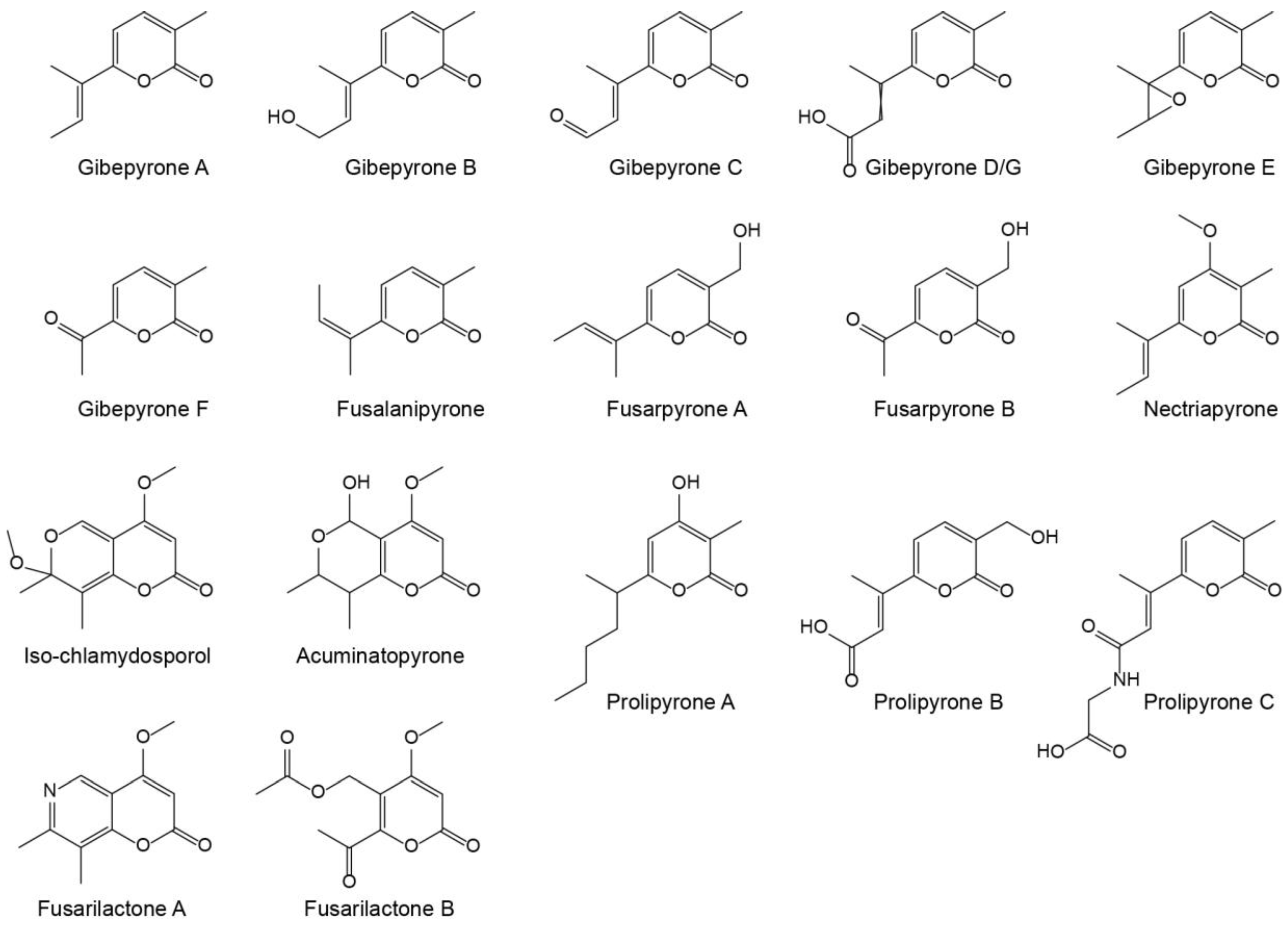
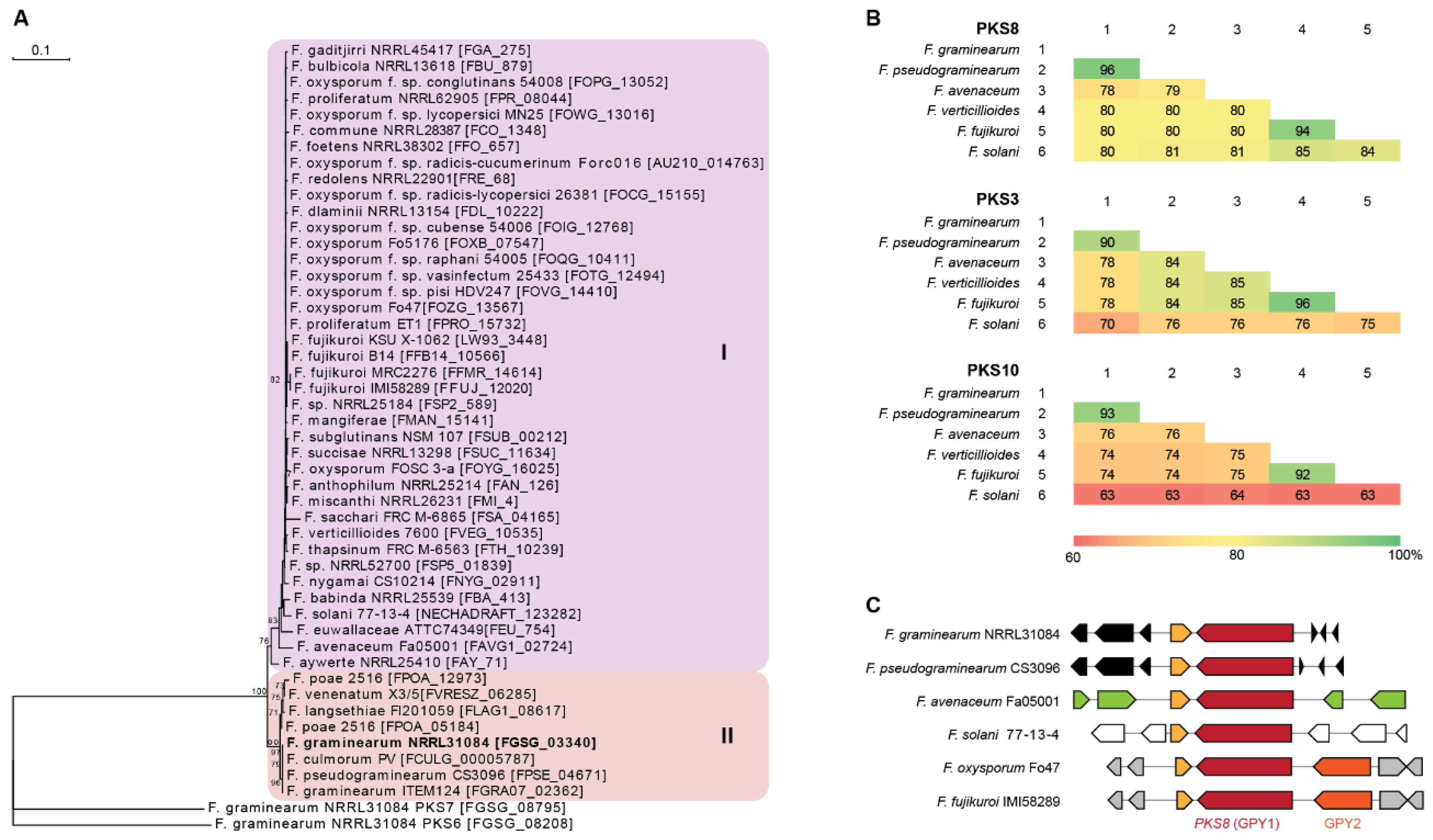
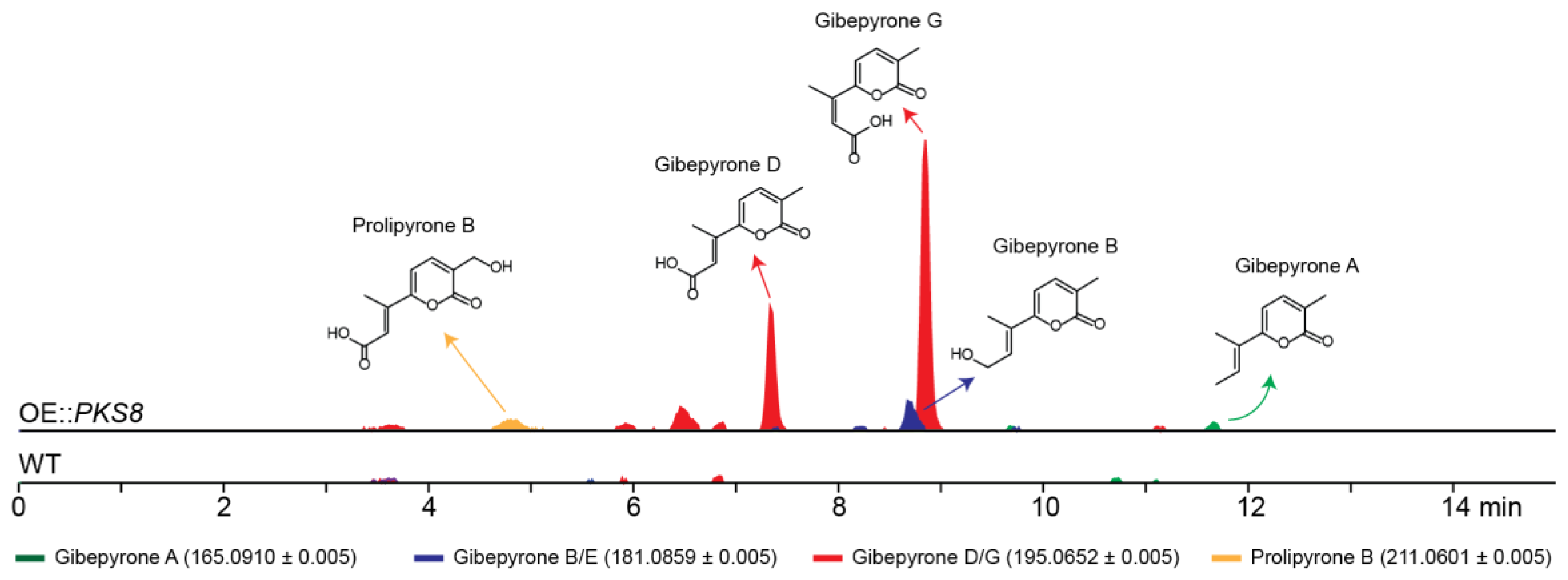

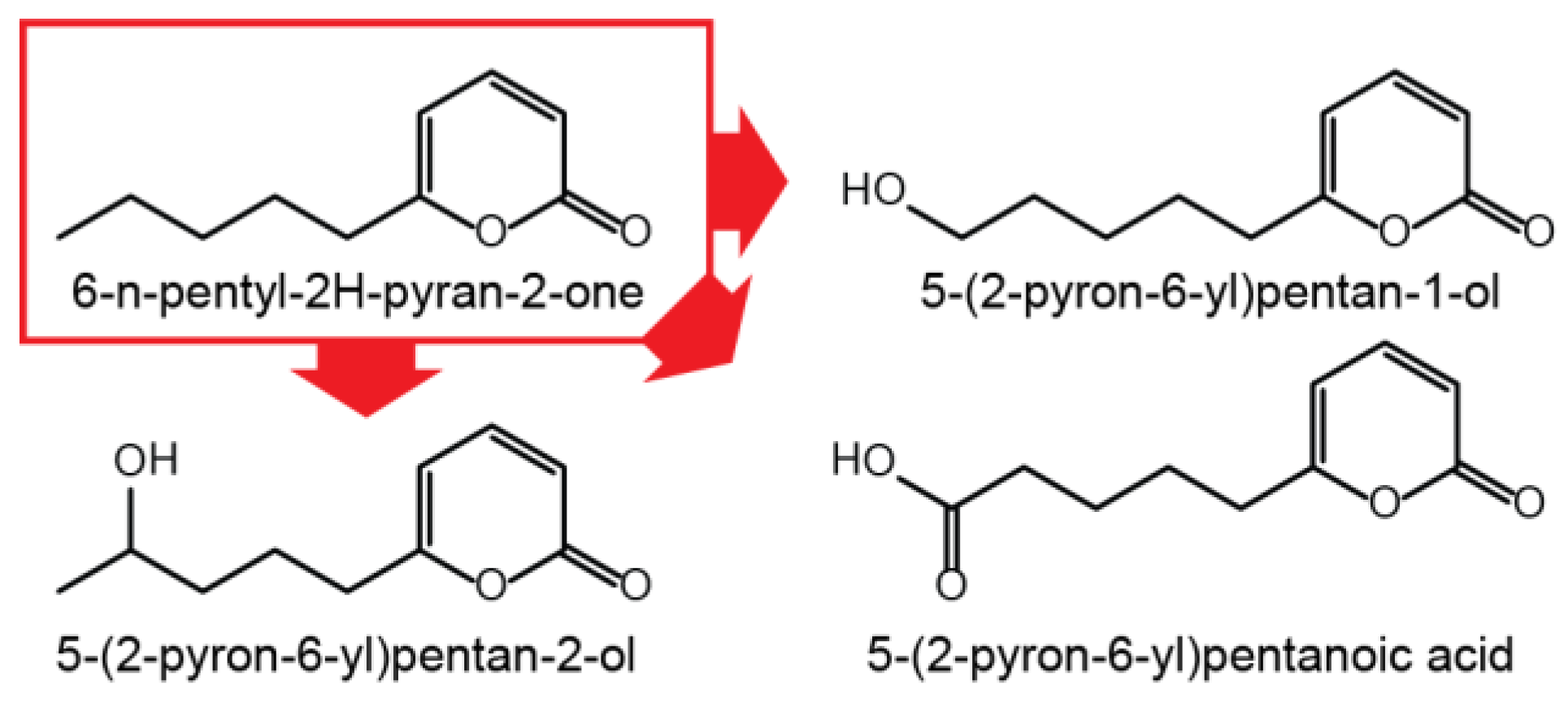
| Gibepyrone D (CD3OD) | Prolipyrone B (DMSO-d6) | 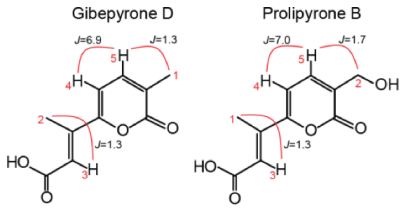 | |||
| type | δH (J in Hz) | Type | δH (J in Hz) | ||
| 1 | CH3 | 2.11 (d, 1.3) | CH3 | 2.31 (d, 1.3) | |
| 2 | CH3 | 2.36 (d, 1.3) | CH2 | 4.30 (s, brd) | |
| 3 | CH | 6.61 (q, 1.3) | CH | 6.45 (q, 1.3) | |
| 4 | CH | 6.70 (d, 6.9) | CH | 6.85 (d, 7.0) | |
| 5 | CH | 7.39 (dq, 1.3; 7.0) | CH | 7.52 (dt, 1.7; 7.0) | |
© 2018 by the authors. Licensee MDPI, Basel, Switzerland. This article is an open access article distributed under the terms and conditions of the Creative Commons Attribution (CC BY) license (http://creativecommons.org/licenses/by/4.0/).
Share and Cite
Westphal, K.R.; Muurmann, A.T.; Paulsen, I.E.; Nørgaard, K.T.H.; Overgaard, M.L.; Dall, S.M.; Aalborg, T.; Wimmer, R.; Sørensen, J.L.; Sondergaard, T.E. Who Needs Neighbors? PKS8 Is a Stand-Alone Gene in Fusarium graminearum Responsible for Production of Gibepyrones and Prolipyrone B. Molecules 2018, 23, 2232. https://doi.org/10.3390/molecules23092232
Westphal KR, Muurmann AT, Paulsen IE, Nørgaard KTH, Overgaard ML, Dall SM, Aalborg T, Wimmer R, Sørensen JL, Sondergaard TE. Who Needs Neighbors? PKS8 Is a Stand-Alone Gene in Fusarium graminearum Responsible for Production of Gibepyrones and Prolipyrone B. Molecules. 2018; 23(9):2232. https://doi.org/10.3390/molecules23092232
Chicago/Turabian StyleWestphal, Klaus Ringsborg, Asmus Toftkær Muurmann, Iben Engell Paulsen, Kim Tanja Hejselbak Nørgaard, Marie Lund Overgaard, Sebastian Mølvang Dall, Trine Aalborg, Reinhard Wimmer, Jens Laurids Sørensen, and Teis Esben Sondergaard. 2018. "Who Needs Neighbors? PKS8 Is a Stand-Alone Gene in Fusarium graminearum Responsible for Production of Gibepyrones and Prolipyrone B" Molecules 23, no. 9: 2232. https://doi.org/10.3390/molecules23092232
APA StyleWestphal, K. R., Muurmann, A. T., Paulsen, I. E., Nørgaard, K. T. H., Overgaard, M. L., Dall, S. M., Aalborg, T., Wimmer, R., Sørensen, J. L., & Sondergaard, T. E. (2018). Who Needs Neighbors? PKS8 Is a Stand-Alone Gene in Fusarium graminearum Responsible for Production of Gibepyrones and Prolipyrone B. Molecules, 23(9), 2232. https://doi.org/10.3390/molecules23092232





